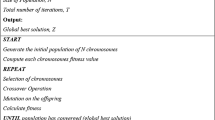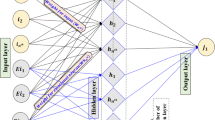Abstract
This paper presents the construction of prediction intervals (PIs) associated with the Emotional Artificial Neural Network (EANN) via the Lower Upper Bound Estimation method (LUBE) and the classic Bootstrap method for the Suspended Sediment Load (SSL) modeling. As point prediction conveys no information about modeling reliability, PIs were applied. The constructed PIs via the EANN were also compared to those of the classic feed-forward Neural Network (FFNN) model. It was attempted to construct the PIs of the SSL modeling in both daily and monthly scales for two watersheds, Upper Rio Grande River, in the United States and the Lighvanchai River in Iran. The PIs were quantified via coverage and width criteria. In the LUBE method, Genetic Algorithm (GA) constructed the PIs by minimizing the cost function of Combinational coverage Width-based Criterion (CWC). Comparison of the results indicated that the criterion of the CWC for PIs of EANN was up to 72% and 78% lower than that to the PIs of the FFNN, respectively, in the LUBE and Bootstrap methods, which showed the reliability of the EANN. In addition, obtained results via the LUBE and the Bootstrap techniques denoted the lower level of uncertainty of the LUBE method. Comparing the CWC criterion of both methods indicated that for the LUBE method, CWC was up to 39% lower than that for the Bootstrap method. Also, the PIs of the FFNN for the Lighvanchai river modeling showed reliable results with CWC of 56% lower than Upper Rio Grande River, but PIs of the EANN led to lower level of uncertainty in Upper Rio Grande River modeling.





Similar content being viewed by others
Data availability
The applied data of the SSL were retrieved from Iran Water & Power Resources Development Co (IWPC) for the Lighvanchai station and from the United States Geological Survey’s website (USGS-https://cida.usgs.gov/sediment/) for the Rio Grande (at Otowi Bridge) station. The data used in the study are available from the corresponding author by request.
References
Alizadeh MJ, Nodoushan EJ, Kalarestaghi N, Chau KW (2017) Toward multi-day-ahead forecasting of suspended sediment concentration using ensemble models. Environ Sci Pollut Res 24(36):28017–28025
Chen X-Y, Chau K-W (2019) Uncertainty analysis on hybrid double feedforward neural network model for sediment load estimation with LUBE method. Water Resour Manag 33(10):3563–3577. https://doi.org/10.1007/s11269-019-02318-4
Chryssolouris G, Lee M, Ramsey A (1996) Confidence interval prediction for neural network models. IEEE Trans Neural Netw 7(1):229–232. https://doi.org/10.1109/72.478409
Danandeh Mehr A (2018) An improved gene expression programming model for streamflow forecasting in intermittent streams. J Hydrol 563:669–678
Devak M, Dhanya CT (2016) Downscaling of precipitation in Mahanadi Basin, India using support vector machine, K-nearest neighbour and hybrid of support vector machine with K-nearest neighbour. In: Geostatistical and Geospatial Approaches for the Characterization of Natural Resources in the Environment, 657–663. https://doi.org/10.1007/978-3-319-18663-4_100
Efron B, Tibshirani RJ (1994) An introduction to the bootstrap. CRC Press
Grant E l, Leavenworth RS (1972) Statistical quality and control. McGraw-Hill, New York
Kargar K, Samadianfard S, Parsa J, Nabipour N, Shamshirband S, Mosavi A, Chau KW (2020) Estimating longitudinal dispersion coefficient in natural streams using empirical models and machine learning algorithms. Eng Appl Comput Fluid Mech 14(1):311–322
Kasiviswanathan K, Sudheer K (2013) Quantification of the predictive uncertainty of artificial neural network based river flow forecast models. Stoch Env Res Risk A 27(1):137–146. https://doi.org/10.1007/s00477-012-0600-2
Khashman A (2008) A modified backpropagation learning algorithm with added emotional coefficients. IEEE Trans Neural Netw 19(11):1896–1909. https://doi.org/10.1109/TNN.2008.2002913
Khosravi A, Nahavandi S, Creighton D, Atiya AF (2011) Lower upper bound estimation method for construction of neural network-based prediction intervals. IEEE Trans Neural Netw 22(3):337–346. https://doi.org/10.1109/TNN.2010.2096824
Lotfi E, Akbarzadeh-T M-R (2013) Brain emotional learning-based pattern recognizer. Cybern Syst 44(5):402–421. https://doi.org/10.1080/01969722.2013.789652
Lotfi E, Khosravi A, Akbarzadeh-T M, Nahavandi S (2014) Wind power forecasting using emotional neural networks. Paper presented at the 2014 IEEE international conference on systems, man, and cybernetics (SMC). https://doi.org/10.1109/SMC.2014.6973926
MacKay DJ (1992) A practical Bayesian framework for backpropagation networks. Neural Comput 4(3):448–472
Morén J, Balkenius C (2000) A computational model of emotional learning in the amygdala. From Animals to Animats 6:115–124
Nourani V (2017) An emotional ANN (EANN) approach to modeling rainfall-runoff process. J Hydrol 544:267–277. https://doi.org/10.1016/j.jhydrol.2016.11.033
Nourani V, Komasi M, Mano A (2009) A multivariate ANN-wavelet approach for rainfall–runoff modeling. Water Resour Manag 23(14):2877–2894
Nourani V, Alami MT, Vousoughi FD (2015) Wavelet-entropy data pre-processing approach for ANN-based groundwater level modeling. J Hydrol 524:255–269. https://doi.org/10.1016/j.jhydrol.2015.02.048
Nourani V, Paknezhad NJ, Sharghi E, Khosravi A (2019) Estimation of prediction interval in ANN-based multi-GCMs downscaling of hydro-climatologic parameters. J Hydrol 579:124226. https://doi.org/10.1016/j.jhydrol.2019.124226
Olyaie E, Banejad H, Chau KW, Melesse AM (2015) A comparison of various artificial intelligence approaches performance for estimating suspended sediment load of river systems: a case study in United States. Environ Monit Assess 187(4):189
Shamshirband S, Jafari Nodoushan E, Adolf JE, Abdul Manaf A, Mosavi A, Chau KW (2019) Ensemble models with uncertainty analysis for multi-day ahead forecasting of chlorophyll a concentration in coastal waters. Eng Appl Comput Fluid Mech 13(1):91–101
Sharghi E, Nourani V, Najafi H, Molajou A (2018) Emotional ANN (EANN) and wavelet-ANN (WANN) approaches for Markovian and seasonal based modeling of rainfall-runoff process. Water Resour Manag 32(10):3441–3456. https://doi.org/10.1007/s11269-018-2000-y
Sharghi E, Nourani V, Najafi H, Gokcekus H (2019) Conjunction of a newly proposed emotional ANN (EANN) and wavelet transform for suspended sediment load modeling. Water Supply 19(6):1726–1734. https://doi.org/10.2166/ws.2019.044
Taormina R, Chau K-W (2015) ANN-based interval forecasting of streamflow discharges using the LUBE method and MOFIPS. Eng Appl Artif Intell 45:429–440. https://doi.org/10.1016/j.engappai.2015.07.019
Thendiyath R, Jha M, Jayakumar D (2020) Neural network modeling for groundwater-level forecasting in coastal aquifers. Neural Computing and Applications Online published. https://doi.org/10.1007/s00521-020-04722-z
Tiwari MK, Chatterjee C (2010) Development of an accurate and reliable hourly flood forecasting model using wavelet–bootstrap–ANN (WBANN) hybrid approach. J Hydrol 394(3–4):458–470
Tiyasha, Tung TM, Yaseen ZM (2020) A survey on river water quality modelling using artificial intelligence models: 2000–2020. J Hydrol 585:124670
Zhou Y (2020) Real-time probabilistic forecasting of river water quality under data missing situation: deep learning plus post-processing techniques. J Hydrol 125164
Zio E, Aven T (2011) Uncertainties in smart grids behavior and modeling: what are the risks and vulnerabilities? How to analyze them? Energy Policy 39(10):6308–6320
Author information
Authors and Affiliations
Corresponding author
Ethics declarations
Conflicts of interest/Competing interests
Not applicable.
Code availability
All codes were provided via the Matlab software and are available.
Additional information
Communicated by: H. Babaie
Publisher’s note
Springer Nature remains neutral with regard to jurisdictional claims in published maps and institutional affiliations.
Rights and permissions
About this article
Cite this article
Sharghi, E., Paknezhad, N.J. & Najafi, H. Assessing the effect of emotional unit of emotional ANN (EANN) in estimation of the prediction intervals of suspended sediment load modeling. Earth Sci Inform 14, 201–213 (2021). https://doi.org/10.1007/s12145-020-00567-1
Received:
Accepted:
Published:
Issue Date:
DOI: https://doi.org/10.1007/s12145-020-00567-1




